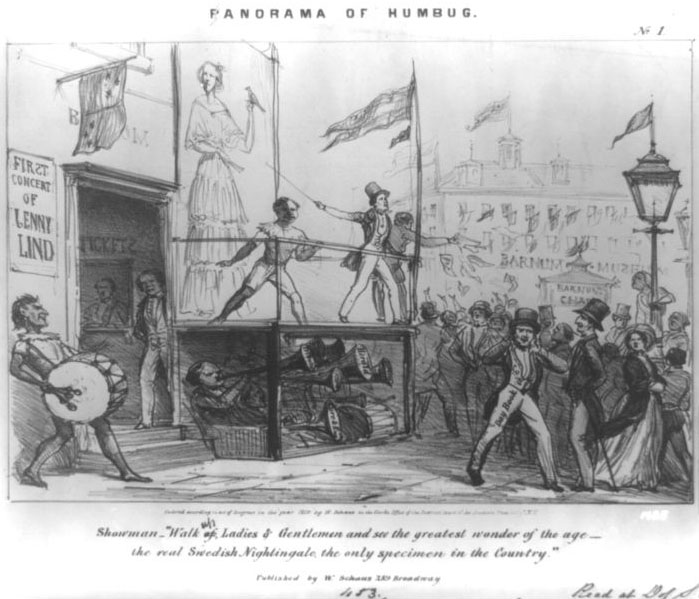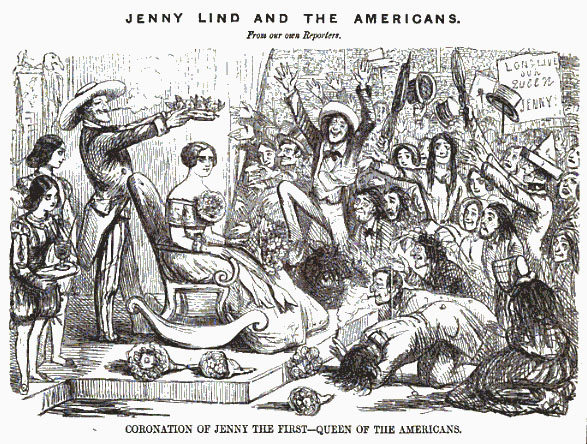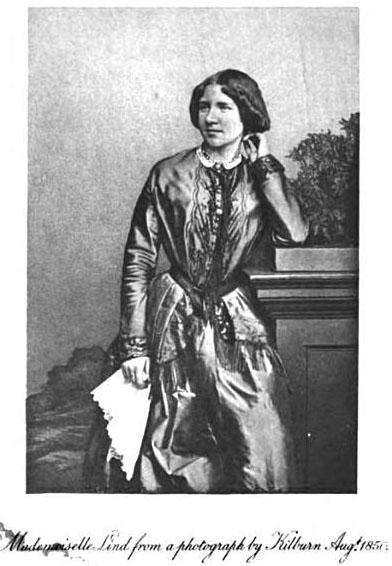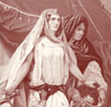In daguerreotypes, Jenny Lind today strikes
us as unexceptional: modestly plain (if not homely), with a serene, even
reserved countenance. This unassuming Swedish woman was an international opera sensation in the nineteenth century. Our inability to hear her voice or
witness her dramatic power may explain why her fame has faded away.
Biographers who wrote tributes to the opera singer during her career
describe her performances with manifest emotion, giving us an indication of
her captivating presence on the stage. Known as the “Swedish Nightingale,” she began in
lower-class obscurity and rose to become recognized by royalty as an
indigenous treasure. On concert tours, overwhelming crowds thronged to greet
her arrival; and, after a show in London, even Queen Victoria threw a bouquet down to
her from the royal theater-box (Rosen). She remained humble in the midst of
celebrity and is esteemed alongside great women of prosopography for her
vocal talents as well as her charitable example—after retiring professionally, she gave free
concerts to raise donations for hospitals and the needy. Rediscovering her
through written accounts, along with a wealth of popular-culture materials,
including ephemera, cartoons and advertising campaigns, creates a picture of
an exceptional figure whose biography intersects with issues of class, the
arts in society, and public women.
In daguerreotypes, Jenny Lind today strikes
us as unexceptional: modestly plain (if not homely), with a serene, even
reserved countenance. This unassuming Swedish woman was an international opera sensation in the nineteenth century. Our inability to hear her voice or
witness her dramatic power may explain why her fame has faded away.
Biographers who wrote tributes to the opera singer during her career
describe her performances with manifest emotion, giving us an indication of
her captivating presence on the stage. Known as the “Swedish Nightingale,” she began in
lower-class obscurity and rose to become recognized by royalty as an
indigenous treasure. On concert tours, overwhelming crowds thronged to greet
her arrival; and, after a show in London, even Queen Victoria threw a bouquet down to
her from the royal theater-box (Rosen). She remained humble in the midst of
celebrity and is esteemed alongside great women of prosopography for her
vocal talents as well as her charitable example—after retiring professionally, she gave free
concerts to raise donations for hospitals and the needy. Rediscovering her
through written accounts, along with a wealth of popular-culture materials,
including ephemera, cartoons and advertising campaigns, creates a picture of
an exceptional figure whose biography intersects with issues of class, the
arts in society, and public women.
In a biographical tribute written shortly after the singer's death, H. S. Holland and W. S.
Rockstro introduce their honorary subject with a comment about
her name which gives us a measure of the impression she made upon the
public:
Even the name of 'Jenny Lind' seemed to be inadequate to the
occasion. It is a name which English lips caress with affection, having in
it the sense and sound of some homely and endearing diminutive. But here,
one felt, was something more than affectionate diminutives could express;
something more than a delicious singer. . . something of a rare and majestic
type, which broke through the ordinary layers which encrust and imprison our
average human life. (6)
Here, the stature of the great woman seems out of proportion with the
public’s terms of intimate affection. Her rise to that stature is all the
more remarkable in light of the lack of love or “affectionate diminutives”
that she received during her neglected and impoverished childhood.
Johanna Maria Lind was born on October
6, 1820 in Stockholm,
Sweden, the daughter of working-class Niclas Jonas Lind
(1798-1858) and Anne-Marie
Fellborg
(1793-1856). She was considered illegitimate until age fourteen when
her parents were wedded, a second marriage for her mother.
Niclas, five years his wife's junior and only aged
twenty-two at Jenny's birth, was the unambitious son of a successful
lace-manufacturer, who failed in the business when it passed on to himself.
He held an unprofitable bookkeeping position and was unable to provide
enough income to support his family, but is described in biographies as
“good-naturedly weak; much given to music of a free and convivial kind”
(Holland and Rockstro 12). While Jenny may have inherited her father's
musical inclinations (he was an amateur singer in community festivals), she
certainly possessed none of his weakness of character. The single-minded
determination she later exhibited in training her voice for opera is a trait
to be found in her mother. Anne-Marie came from a respectable
family and was well-educated, qualities which enabled her to earn a living
as a schoolmistress when Niclas proved incapable of providing
for her. In 1820, she was running a day-school for girls out of
their home, where two of the students also boarded. Occupied with the
financial concerns of the household, the mother gave the new baby little
welcome and soon placed her daughter in the care of strangers.
Until
1824, Jenny lived in the countryside with a couple, a
parish-clerk and organist and his wife. While she was neglected by her
parents in early childhood, this was not an entirely unhappy period of her
life. Listening to the songs of wild birds, she felt an intense love for the
Swedish countryside that she retained even as an accomplished opera
singer—a national “instinct…native to the Swedes,”
according to biographers. The passion for “the country” had “deep-rooted
dominion” over Jenny Lind, and in turn she personified country folk.
She was in close touch with all that belongs to a simple
peasantry. She knew the tones of its songs; and the rhythm of its dances;
its simplicity, its charm, its pathos—all were hers. Something of its native
depth and dignity seemed to have passed into her. (Holland and Rockstro
13)
During her musical career as the “Swedish
Nightingale,” this indigenous quality was cherished by
international audiences of all ranks and the combination of homeliness and
powerful feelings which she displayed in performance was part of her common
appeal.
While Jenny's years in the countryside made a lasting impression, they were
short-lived. In 1824, she was brought back to town and for a
period of time, lived with her grandmother in a respectable almshouse for
the widows of Stockholm burghers. Here, she received affectionate care and
was taught a sense of religion and morality which guided her later charity
work. Her grandmother was the first to recognize the small child's musical
abilities, overhearing her one day at the piano and thereafter, her natural
talent was celebrated by neighboring widows who came to hear her sing.
Around 1828, her mother's day-school closed and economic
constraints once again disrupted Jenny's home-life. She was handed over to
the care of a childless couple who had placed an advertisement in the paper
for a child to come live with them. The husband was the steward and tenant
in the lodge-house of the same almshouse where her grandmother lived, so
happily, she was not removed from all familial relations when her mother
left Stockholm shortly after to take a governess position. However, in this
couple's guardianship, she spent many hours alone and a cat became the
audience for her songs. The clear, high voice carried to other ears, and one
of the people who heard from the street changed the course of Jenny's
life.
The
anecdote of her discovery is lovingly retold in nearly all biographies. The
version one presenter includes as having come from the singer's recollection
and recorded by her son, may be considered relatively authoritative:
Her favourite seat with her cat was in the window of the
Steward's rooms. . . and there she sat and sang to it; and the people
passing in the street used to hear, and wonder; and amongst others the maid
of a Mademoiselle Lundberg, [the principal] dancer at the Royal
Opera House; and the maid told her mistress that she had never heard such
beautiful singing as this little girl sang to her cat….[When] Mademoiselle
Lundberg….heard her sing, she said, 'The child is a genius; you must have her educated for
the stage.' (Holland and Rockstro 17)
Included in this version, but not in the one to follow, is the detail that it
was a maid who first appreciated the beauty of Jenny's voice before
Mademoiselle confirmed the discovery. One can speculate that the maid's
absence from other versions is due to the uncomfortable suggestion that a
lower-class person might have discerning taste, whether or not acquired in
service to an artistic mistress. Regardless of narrative intent, the maid,
when she is present in the story of Jenny's discovery, figuratively predicts
the appeal the singer had in her career to not only high, but low audiences,
as well. The tone of this version of the discovery is strikingly
different:
There was once a poor and plain little girl dwelling in a little
room, in Stockholm, the capital of Sweden. She was a poor little girl indeed
then; she was lonely and neglected, and would have been very unhappy,
deprived of kindness and care so necessary to a child, if it had not been
for a peculiar gift. The little girl had a fine voice, and in her
loneliness, in trouble or in sorrow, she consoled herself by singing. In
fact, she sung to all she did; at her work, at her play, running or resting,
she always sung.
The woman who had her in care went out to work during the day,
and used to lock in the little girl, who had nothing to enliven her solitude
but the company of a cat. The little girl played with her cat and sung. Once
she sat by the open window and stroked her cat and sang, when a lady passed
by. She heard the voice, and looked up and saw the little singer. She asked
the child several questions, went away, and came back several days later,
followed by an old music-master, whose name was Croelius
[singing-master at the Royal Theater]. He tried the little girl's musical
ear and voice, and was astonished. (Willis 5)
When the discernment of Jenny's talent originates with the lady, the story
can be placed in a neatly defined package. The woman of a better class
provides charitable assistance to one of the less fortunate class: a secure
hierarchy—as opposed to the destabilizing potential when a servant assists a
poor girl to rise to the level of renown that is recognized by royalty, her
name is on the lips of kings and queens. This presenter elects to replace
Jenny's name with “(poor) little girl,” and inflects the story with such
pathos that ones can see the tendency towards reducing her to “endearing
diminutives” which Holland and Rockstro suggest
obscured the public's recognition of her rare and intense artistic talent.
The maudlin affect veils the slippage between class and status
boundaries—what I consider to be the most critically significant part of her
biographical story—in the 'once upon a time' of fairy tales.
Although the
head of the Royal Theater of Stockholm nearly rejected Jenny when he saw
her—“a small,
ugly, broad-nosed, shy, gauche, under-grown girl!” (a
self-description from one of her letters)—she was accepted at the Royal
Opera School after he was moved to tears by her voice (Holland and Rockstro
18). There, she found her home on the stage. The Royal Theater assumed
guardianship of her and she was brought up, educated and received vocal
training at the expense of the government. By age ten, she made her first
appearance singing and dancing on stage and continued to play children's
parts in productions. Yet at adolescence, her voice changed; it lost the clarity
and high tone which had received so much praise. Several years passed before
Jenny would gain the chance to debut in the theater of Stockholm; however,
with determined study she mastered the new quality of her voice. Such a
trial would occur again at the height of the opera singer's career, when she
lost her voice and had to learn how to retrain it before she was able to
return to performing. Her commitment through this early ordeal signaled that
she had taken on singing as work. No longer the little girl who was
discovered to have such talent, Jenny Lind had claimed for herself the place
of a serious professional artist.
On March 7, 1838, audiences made a sensation of her performance
as Agathe in Carl Weber's
Der Freischütz. This was the first great role of
Jenny's many onstage triumphs and made her a favorite of the Royal Swedish
Opera. At age 20, she was accepted as a member of the Royal Swedish Academy
of Music and was appointed as a court singer to the royalty of Sweden and Norway. However, her popularity strained her
voice; over-exertion left it sounding harsh. Determined again to save her
musical powers, she traveled to Paris
seeking Manuel García, the famous baritone who became a vocal
instructor for the Paris Conservatory, and later, the Royal Academy of Music
in London. Before forbidding her to sing a note for three months, he
famously told her: “My
dear child, you have no voice. Or, you have had a voice and are just
going to lose it” (Lind-Goldschmidt 13). The period of silence
repaired her voice, and nearly a year's tutelage under García
saved the opera-singer's career. When Jenny returned to the stage, audiences
were not fickle to their one-time favorite, but immediately embraced her
again.
Not only was she appreciated in performance, but she was also welcomed in
literary and artistic circles of society. Though she lacked the beauty and
sophistication of the usual prima donna, she evidently blended in easily at
refined soirees, as an anecdote about her posing in a recreation of an
Italian Baroque painting at a party of fellow-artists suggests:
she appeared, at a Stockholm party, in a tableau-vivant, as
Carlo Dolce's St Cecilia [the patron saint of musicians]: and it was said
that she looked exceedingly like the picture: and she took special delight
in this personal resemblance to the Saint Cecilia; and after her death there
was found, among her private stores of little mementoes [sic], the rouge-card used at the tableaux, with her own writing on
the back to say that it had been given her by Fredrika Bremer as a memorial
of that evening. (Holland and Rockstro 85)
Along with novelist Fredrika Bremer, Jenny was intimate with
many significant figures of literature and music, including Hans
Christian Andersen, sculptor Georg Jensen, and
composers Mendelssohn, Chopin,
Meyerbeer, and A.F. Lindblad, “the Schubert of
Sweden” (Holland and Rockstro 4). Although she appeared
unsophisticated, the dramatic range of the roles she played mirrored a depth
of character which many found to be personally, as well as artistically,
engaging. These relationships showed her to be exceptional in several ways:
she was of the lower class yet many recognized an inherent sense of
refinement about her; she was a popular entertainer yet recognized by
cultured members of society as an artist of their own kind; and she was a
woman of the Victorian era publicly accepted into the company of men. One
biography notes the admiration Jenny's character won amongst serious minds:
“Its peculiar force lay in this—that it held enthralled the highest and best
minds in Europe. It was the men of genius who recognized in her something
akin to themselves” (Holland and Rockstro 4). In her late twenties, she was
inducted as the only female member of a student fraternity in Göttingen, Germany called
Burschenschaft Hannovera. Amongst the men of this classical German
organization she was fondly known as “Little Lady
Jenny”—endearing diminutives were attached to her name even as
she was distinguished from a commonly recognized form of femininity (Holland
and Rockstro 375).
For some of those who knew Jenny, esteem for her rare character and intellect
developed into romantic interest. Her fine grey eyes and sincere nature
captured the heart of Hans Christian Andersen when he met her during a
concert tour of Denmark, prompting him to write two of his most famous
stories in her honor, The Ugly Duckling and The Nightingale, the source of her stage name the
“Swedish Nightingale.” She was also an inspiration for
Mendelssohn as well as Chopin, both of whom
composed operas with her voice in mind. While nineteenth century biographies
acknowledge her professional relationships with these two men, a more
intimate association was not considered until new biographical information
surfaced that could unsettle some revered reputations. Professor
Curtis Price (formerly of the Royal Academy of Music in
London) claims in a recent biography on Mendelssohn that the married
composer was desperately in love with the singer. Price alleges that in
1847, Mendelssohn begged her to elope with him and
threatened suicide upon her refusal. A few months later, Mendelssohn was, in
fact, dead; however, this scandal of musical history remains a speculation
since the documents were sealed by an affidavit secured by Lind's husband in
1896. Jenny's requited romance with Chopin has been
publicly substantiated, though only very recently has it been discussed in
biography. Evidence shows that she obtained Queen Victoria's approval to marry him 1849. The
union never occurred because Chopin was fatally ill, but Jenny is said to
have sung at his bedside while the composer was dying. On February
5, 1852, while touring America, she married pianist Otto Goldschmidt (who had been one of Mendelssohn's
pupils), becoming a new bride at the rather late age of thirty-one.
Jenny's American concert tour greatly increased her fame, but her association
with P.T. Barnum, who financed the tour, had an unfortunate
impact on her reputation. Under the strain of continuous performance, the
exhausted singer was considering a transition to retirement, wanting to
commit herself to benefit appearances only. Barnum convinced her to make a
tour of America by promising that she would earn enough money to pay for her
retirement and fund her project of establishing several new schools in
Sweden. Counting on the extraordinarily high ticket sales of her tours in
Great Britain, the self-titled “Greatest Showman on Earth” introduced the
“Swedish Nightingale,” hitherto unknown by American audiences, in
advertisements touting her moral purity and social benevolence as much as
vocal talent. He began publicizing the tour half a year in advance of her
arrival, citing the free benefit concerts she had given as a promotional
tool to increase his profits from the 150 shows she was contracted for
(after 93 performances, she ended their agreement). While Jenny donated
nearly all of the $250,000 she made during the tour, Barnum's commercial
exploitation muddied what, for her, was a genuinely altruistic use for her
immense celebrity. Critics focused on the spectacle made of and by her in
the United States and her charitably intended tour was repeatedly parodied
in the press.

A cartoon by New York engraver William
Schaus entitled “Panorama of Humbug” (1850) satirizes the extent
of the advertizing campaign that Barnum orchestrated to launch the “Swedish
Nightingale” to popularity before she even sang a note for an American
audience.
[1] It shows the public frenzy
that greeted her arrival being created by showmen campaigning on the street
as Barnum watches from behind a curtain in an inconspicuous corner of the
picture. A colossal image of Jenny, nightingale perched in hand, dominates
the background and immediately draws our eye to her; an optical effect which
ironically mimics the humbuggery being scrutinized. The cartoon shows the
friction between her marketability as an eminent figure and her efforts to
make philanthropic use of her eminence. At the same time, her hugeness in
the picture suggests another reading: that Barnum's puffery as unnecessary
because the reputation which earned her such public stature served as its
own advertisement.

The approval Barnum generated for the singer before
audiences even heard her voice corroborated claims from across the Atlantic
that the taste of the American public was guided by popular opinion rather
than refined discrimination. A cartoon called “Coronation of Jenny the
First—Queen of the Americans” (1850) which appeared in
Punch is a satirical comment upon the lack of sophistication
amongst her American fans.
[2] Before a raucous
and apparently low-classed crowd of people, some prostrate in homage, some
whooping and leaping, sits Jenny, being crowned as their popularly elected
Queen. Paradoxically, the reference to her royal associations reminds us
that the high shared their appreciation of her with the low, challenging the
association between lack of taste and lack of status. As though she were
Victoria, whom the cartoon rendering immediately calls to mind, Jenny's
countenance is as gravely sober as if she were being charged with royal
responsibilities. Imaging her as a double for Victoria (even though it was
intended to be a parody) encourages us to consider these two women
collectively, as both were in highly public positions at the same time as
they were figures of feminine virtue for an emerging middle-class
ideology.
The effect of collecting forms of womanhood is present in another cartoon
titled “To Jenny Lind, From Punch,” which makes satire of one of the only
public roles that Victorian women could engage in without compromising their
femininity: charity work. Jenny is shown in the middle of the picture
holding a basket of food—an object symbolizing the charitable woman's
mission. She stands in a Madonna-like pose, her eyes are downcast, her arm
and hand extended to comfort the impoverished crowd of shoeless wretches and
mothers bearing infants, who kneel in a circle at her feet. This exaggerated
portrait of the ministering angel parodies Jenny's philanthropic activities;
yet at the same time, the cartoon's figure for satire runs up against
prosopography, which uses the same topos image to present genuinely worthy
heroines as models for women's public contributions. Many of the ministering
figures found in collected biography shared the mission of charity work and
Jenny, who donated concert proceeds to Florence Nightingale's Nursing Fund at the end of the Crimean
War, provides us with an example of one heroine supporting a cause
championed by another.
Although she continued to give performances to raise money for the needy,
Jenny retired from her professional stage career when she completed the
concert tour of America in 1852. The Goldschmidts settled into
the calm of domestic life and raised two sons, Walter and Ernest, and a daughter who shared the same
endearingly diminutive name as her mother. In 1883, Jenny gave
her last charitable performance and during the same year, her vocal talent
received one more public acknowledgment when the Prince of Wales appointed
her as the first professor of singing at the newly established Royal College
of Music. On
November 2, 1887, Jenny died of cancer at her home in
Wynd's Point, England. Although this phenomenal celebrity of the nineteenth
century has been largely forgotten today, evidence of her popularity is
preserved in an incredible amount of material culture from the era. Her name
and image can be found on everyday items from cigar boxes, hard liquor,
perfumes, plate ware, tea sets, furniture, pastry recipes, even train cars.
Jenny's legacy as a professional artist earned her a place in high culture
alongside her male peers. Near Handel's statue in Poet's Corner at Westminster
Abbey, a plaque is dedicated in honor of her musical accomplishments.
Notes
1 William Schaus, “Panorama of Humbug” (New
York: W.Schaus, 1850).
2 “Coronation of Jenny the First—Queen of the
Americans.” Punch 19 (1850): 146.
Works Cited
Holland, Henry Scott, and William Smyth Rockstro. Memoir of Madame Jenny Lind-Goldschmidt: Her Early
Art-Life and Dramatic Career, 1820-1851. Vol. I &
II. London: J. Murray, 1891.
Lind-Goldschmidt, Johanna Maria. Memoir of Jenny
Lind. London: John Olliver, 1847.
Rosen, Carole. "Lind, Jenny (1820–1887)." Oxford
Dictionary of National Biography. Ed. H. C. G. Matthew
and Brian Harrison. Oxford: OUP, 2004.
Willis, Nathaniel Parker. Memoranda of the Life
of Jenny Lind. Philadelphia: Robert E. Peterson, 1851.













